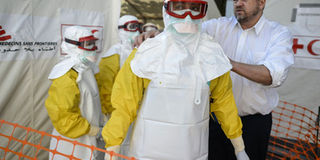Flu or Ebola? US hospitals get ready for a confusing season

International Federation of Red Cross (IFRC) senior officer (right) inspects protection clothes during a pre-deployment training for IFRC and medical charity Medecins Sans Frontieres (MSF) staff heading to Ebola area on October 29, 2014 at the IFRC headquarters in Geneva. After weeks of Ebola panic, false alarms and quibbles over quarantine in the United States, health authorities are bracing for a new battle: flu season. PHOTO | FILE |
What you need to know:
- The end of October marks the start of influenza season, bringing with it the predictable sniffles, sneezes, fever and aches that can extend well into the spring months.
- Nor is there any treatment on the market to cure or prevent Ebola, though experimental vaccines are being fast-tracked.
WASHINGTON
After weeks of Ebola panic, false alarms and quibbles over quarantine in the United States, health authorities are bracing for a new battle: flu season.
The end of October marks the start of influenza season, bringing with it the predictable sniffles, sneezes, fever and aches that can extend well into the spring months.
But this year is different for two reasons. First is the Ebola epidemic in West Africa that spilled into the United States when a Liberian man travelled to Texas in September and infected two nurses who helped care for him.
The second is the late summer outbreak of enterovirus D68, a respiratory illness that has sickened more than 1,100 people in 46 states since August, the US Centres for Disease Control and Prevention said.
Most areas of the country are reporting a decline in EV-D68, but seven states including California say they are still seeing increases.
There is no vaccine against the EV-D68, which has been linked to paralysis and neurologic symptoms in a small number of child patients.
NO CURE
Nor is there any treatment on the market to cure or prevent Ebola, though experimental vaccines are being fast-tracked.
The prospect of facing all three illnesses in a single season has led the CDC to start a public education campaign to help people understand the risks, and to remind people to get their annual flu vaccine.
“There may be some public concern or confusion between seasonal influenza and Ebola this season,” a CDC spokeswoman said in an email to AFP, citing past experience with fears over the Middle East respiratory syndrome (Mers) and Severe acute respiratory syndrome (Sars).
“Flu-like symptoms in US residents this flu season will most likely be caused by seasonal influenza, not Ebola.”
COMMON SYMPTOMS
Flu and Ebola share some common symptoms, such as fever, headache, fatigue and aches and pains.
But there are big differences, too. Influenza causes cough, sore throat and runny nose, while Ebola does not.
Ebola leads to vomiting and diarrhoea within three to six days, severe weakness and stomach pain, as well as unexplained bleeding and bruising.
To illustrate these differences, the CDC has issued a flyer titled “Flu or Ebola?” that offers a side-by-side comparison, available at www.cdc.gov/vhf/ebola/pdf/is-it-flu-or-ebola.pdf.
The simple, bold print is accompanied by graphics, including one person sneezing on another to show how flu transmits by droplets spewed when sick people cough, sneeze or talk.





